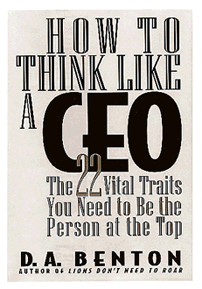How to Think Like a CEO: The 22 Vital Traits You Need to Be the Person at the Top by D.A. Benton
How to Think Like a CEO: The 22 Vital Traits You Need to Be the Person at the Top by D.A. Benton (463 pages, Warner Books, 1996)
(originally published by Booz & Company) Corporate America has always loved recipes for success. If anything, they have become even more enticing in today's volatile workplace. All of which bodes well for Debra Benton's How to Think Like a CEO, which appeals engagingly to our insatiable appetite for formulas (especially ones with numbered lists) about how successful people get that way.
Corporate America has always loved recipes for success. If anything, they have become even more enticing in today's volatile workplace. All of which bodes well for Debra Benton's How to Think Like a CEO, which appeals engagingly to our insatiable appetite for formulas (especially ones with numbered lists) about how successful people get that way.
Despite its title, which suggests it is just for C.E.O.'s-in-training, this book speaks to a broad audience — from managers who just want to hang onto their jobs to chiefs who would like to improve their leadership style.
Ms. Benton, an executive coach, starts with the premise that by understanding C.E.O.'s, you can not
only turn into one, but can also deal more effectively with people at the top. "Act like the chief to become the chief," she tells us. Or, if the C.E.O.'s job is not what you are after, you can learn to avoid getting fired or win faster promotions or simply enjoy work more.
On our behalf, Ms. Benton has gone to many corporate leaders and asked some questions we might like to have answered: What do the winners have in common? How did they reach the career pinnacle? What do they look for in others? Based on these interviews, and on what she has read in the business press about other C.E.O.'s, the author derives a list of 22 "vital traits" for what she calls the "near-perfect" corporate leader.
At the heart of this book is the modern truism that "competence, hard work, intelligence and ambition" aren't enough to get us ahead. For Ms. Benton, vital traits are the tie-breakers. Near-perfect C.E.O.'s do not always show all of these traits, but "use a lot of them a lot of the time," she says. Whether or not she's right, Ms. Benton is a good teacher and storyteller (which is the 22d vital trait) who dishes up plenty of practical career advice.
Part one of the book, which lays out the vital traits, includes few surprises. Some traits — being secure about yourself (even if you have to fake it), good at your job and willing to lead as well as being nice, humorous, original, competitive and flexible — seem fairly straightforward (still another "vital" trait). Others are reminders of how we ought to be (in control of attitudes, honest and ethical, a fighter for your people).
Still, two things propel us through this highly readable book. One is a (competitive?) desire to see whether we measure up, and assess our own prospects for getting ahead. The other is the many memorable anecdotes Ms. Benton has gathered to illustrate what might otherwise seem like fairly routine tips.
To personify the fourth vital trait — continuously improving — she features James Burke, the former chief executive of Johnson & Johnson. One day, presumably early in his career, Mr. Burke gets called into the chairman's office to discuss a product that failed, at a cost to the company of $865,000. Mr. Burke is sure he is about to get fired, until the chairman shakes his hand and congratulates him. "Nothing happens unless people are willing to make decisions, and you can't make decisions without making mistakes," the chairman says to a much-relieved protégé. But he quickly adds a qualifier: "If you make the same one again, you're through."
An incoming president of the San Francisco United Way shows he is inquisitive (19th vital trait) when he hops a taxi from the airport one day. "Do you know anything about how the United Way is doing in the city?" he asks the driver. When the cabby responds, "They are in deep trouble," the executive learns something he has not heard from United Way higher-ups — something that turns out to be true.
It is also inspiring to hear that many high achievers don't make it on the first try, but have to be tenacious (vital trait No. 3). Here Ms. Benton offers the example of Harold Sperlich, a product engineer at the Ford Motor Company, who pushed his employer, without success, to introduce the minivan. As Ms. Benton tells it, Mr. Sperlich got fired from that job but went on to the Chrysler Corporation, where Lee Iacocca took him up on the idea.
Many other non-C.E.O.'s find their way into this book, presumably because Ms. Benton judges them to have one vital trait or another. Even the author makes a number of appearances. After a cable company C.E.O. keeps her waiting for an appointment, she starts a meeting by saying in a friendly voice, "I don't think this appointment is very important to you, is it?" (Vital trait No. 10: gutsy/a little wild.) The C.E.O. winds up hiring her consulting firm for an assignment.
Another time, Ms. Benton confesses, she overlooks the key vital trait of thinking before talking. As a guest speaker at a Missouri college, Ms. Benton gets assigned to dorm-room accommodations that are less than first class: no hot shower, no telephone in the room and no TV. She slips out and spends the night at a more commodious hotel. En route to her next destination, she shares the details with a fellow traveler. Too bad he turns out to be the college president.
Part two of the book — roughly the last third — looks behind the scenes at what people encounter once they get to the top, and how they behave there. This section has less of a unifying theme than the first part, but again, plenty of human interest.
Ms. Benton covers what C.E.O.'s get paid (25 times as much as the lowest-paid employee in the corporation is "typical"; 100 times as much is "extreme"), the ins and outs of an average day (most of which consists of meetings) and surprises C.E.O.'s face (former friends may become enemies). She also extends advice about everything from giving and receiving criticism to how to hold fewer meetings.
A chapter called "Moving On" describes what C.E.O.'s look for when they hire and advance others: self-promoters who have a good attitude, can get results and do more than the next person. People who are in danger of getting fired tend to be low producers, those with a negative attitude or individuals who don't follow up, she says.
For people with problem bosses, Ms. Benton sends conflicting messages about how to get ahead. On the one hand, she emphasizes the need to "pick a good boss to learn from," and advises people who work for a bad one to quit. On the other hand, she correctly notes that in today's turbulent workplace, it's sometimes possible to outlast a problem leader. While Ms. Benton seems to have spent a great deal of time in the corporate world, she's been self-employed for most of it. Inevitably, her entrepreneurial spirit colors her advice.
As a woman running her own business, Ms. Benton has also avoided the glass ceiling — another reality of corporate life that she fails to tackle head-on. With the exception of Barbara Thomas, president of Pillsbury Canada Ltd., there are few high-ranking women at major corporations named in this book. Linda Wachner, the C.E.O. of the Warnaco Group, gets a mention as the only female head (at the time of writing) of a Fortune 500 company that isn't family owned. Unfortunately, we hear nothing more about her.
Although Ms. Benton notes that "women are progressively joining" the ranks of C.E.O.'s, she virtually ignores those on the way up, including three who got big promotions just this year: Jill Barad, who became chief executive of Mattel; Lois Juliber, named to head North American and European operations at Colgate-Palmolive (making her a leading contender for the company's top post), and Gail McGovern, put in charge of AT&T's $26 billion consumer business.
Nor do we find as many first-hand appearances by top-ranked male C.E.O.'s as we might expect in a book like this. The author seems to have interviewed some major players, like Bill Hewlett, co-founder of Hewlett-Packard; Leonard Abramson, C.E.O. of US Healthcare, and Michael Eisner, the C.E.O. of Disney. And research from an earlier book yielded material about leaders from Colgate-Palmolive, ARCO, Heinz and Adolph Coors. But a lot of other material is presented without attribution, drawn from the minor leagues or based on secondary sources (as Ms. Benton does with anecdotes about Bill Gates and Mr. Iacocca).
By her own admission, Ms. Benton had access problems. She tells us that the idea for her book "wasn't warmly received by everyone." Upon hearing of Ms. Benton's study, Laurence Kirshbaum, president of her publisher, Warner Books, reportedly said, "Good grief. Good luck."
Fortunately, Ms. Benton reached enough people to successfully execute her highly creative idea. And her own expertise and business savvy are no doubt a valuable supplement to what others told her. The net result is sensible advice in a lively package.
Will it guarantee our ascent to the summit, as the author promises? Probably not. But cultivating at least some of the vital traits certainly can't hurt. ![]()


